
In the Myth of the Minotaur, if not for the ministrations of the humble Princess Ariadne, Theseus—the Greek hero—would not have had a prayer. Although often portrayed as a mere maiden, truth be told, providing back-up for a leading man was the very least of her qualities. Springing from the heavens, Ariadne’s origins beckon from the primordial mist of Bronze Age Minoan Crete where she was the overarching mother goddess in the Minoan pantheon—the all-important fertility goddess who is believed to have answered to such titles as goddess-on-earth, weaver of life and mistress of the labyrinth.
Ariadne Minoan Fertility Goddess
With the destiny of mortals in her hands, Ariadne was considered a bright goddess, often compared to Demeter—whose celestial origins were from Crete as well. In some ways Ariadne is analogous both to the goddess of the harvest—and her daughter Persephone—queen of the underworld. Predating patriarchy, the mother goddess’s role was paramount—in agricultural societies religion was centered on fertility and everything was centered on religion. Because Minoan Crete was a matrilineal society with women leading lives of independence, like all goddesses in the Minoan pantheon, Ariadne ruled alone without a male consort. Toward the close of the Minoan civilization—with the Mycenaeans’ influence keenly felt—Ariadne began to be accompanied by a young male consort. Her insignia, the labyrinth—a square or circular structure with multiple circuits spiraling to the center and back again—figures prominently in her mythology and is believed to have been a place of initiation where mortals moved from one realm to another with the bull-god—the Minotaur (Hades-like)—occupying its deepest and darkest center.
……………………………

From supreme earth mother to a gullible princess, who was the real Ariadne? Find out in my book Unsung Heroes on Amazon.

This essay was extremely informative in its terseness, Mary, and I was able to follow the thread of your thoughts and understanding of antiquity in transitions from agricultural cooperative to warrior punative. I started off curiously attached to the Canaanite Asherah (and see now you are as well) but “switched”, so to speak, to Ariadne after comparing ancient Canaanite society with Cretan/Minoan society. I have traveled to Israel/Lebanon and Crete to get a feel for the histories and the lands that gave birth to both. Certainly, the Minoan/Goddess culture I felt a deeper resonance with, Thanks
Wondering how they figure the young Greek women married middle aged men. What kind of record attested to that?